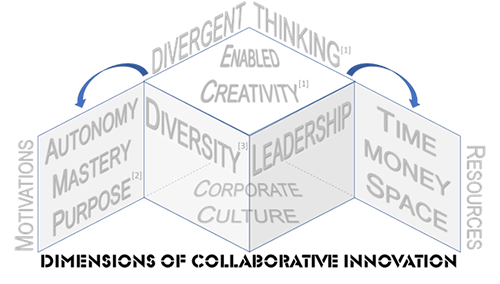Dimensions of Collaborative Innovation

Photo by Silvio Kundt on Unsplash
Author: Fred Robinson
You might be thinking, “Ugh, not another innovation post!” That is often my own reaction, having also read and heard so many different pitches, each offering some singular source or step-wise approach promising that innovation will follow. My Spidey-sense rankles when I’m offered narrow and/or occasionally short-sighted perspectives on innovation because I know by now that there has to be more to it.
A recent discussion with colleagues on intriguing approaches and paths to innovation triggered my systems thinking habits—to explore and understand challenges systemically. What I ended up discovering were multiple dimensions of innovation, particularly for collaborative innovation.
A particularly favorite systems thinking habit for me is to recognize that a systems’ structure influences its behavior. Most of the communication systems that intellectuals use to describe innovation are themselves flat, literally, their messages delivered in one or two dimensions. I remember watching a movie version of Flatland (from the 1884 story by Edwin Abbott) in elementary school and realized even then how expanding our perspectives beyond our native dimension lets us better understand the broader environment.
Said simply, a dimension is something that can vary or change independently while everything else remains unchanged. Systems thinkers can leverage dimensionality to improve understanding of a challenge, perhaps moving back to see the big picture, changing views to appreciate multiple perspectives, or exploring meaningful connections within or between elements. I believe innovation needs a multi-dimensional view to better embrace its complexity. I started with a cube to reflect the variety of innovation-promoting aspects within collaborative environments, each face representing a different dimension of influence.
In my search for understanding around innovation, only a few voices have stood out from the crowd of oracles: Sir Ken Robinson, Dan Pink, and Franz Johansson. Each orator offers a promising approach to discovering a path to innovation, but no single view seems complete. I began to design my cube as a way to build coherence where I observed dissonance and to explore the relationship of these innovators and others. Addressing teaming as an addition and amplifier of innovation opportunities, I was finally able to conceive this cube-based framework—Dimensions of Collaborative Innovation—seen here, with each dimension unpacked below.

In the RSA Animate presentation of Ken Robinson’s speech on Changing Paradigms, he tells us that an individual’s divergent thinking must be encouraged, as divergent thinking applied is what enables creativity. When we encourage our staff to apply their creativity to critical challenges, they can expose novel opportunities for discovery and innovation [1]. Ken’s contribution is represented in the dimension on the top of the cube.
Through the Medici Effect, as shared in a TEDx-NASA video, Frans Johansson suggests more innovation opportunities arise through the power of the crowd versus what can be realized by an individual. Working collaboratively to think through challenges, teams assembled from across the available crowd increase the opportunities for differentiated approaches or solutions. Diversity in this context is about variability in thought rather than demographics. Teams that embrace diversity of thought while breaking down challenges into their smallest executable steps can increase opportunities for innovative discoveries [3]. Frans’ contribution is represented in the front face to the left of center.
Dan Pink’s RSA Animate presentation on Drive focuses on identifying the motivations for intrinsically driven individuals who need to think through the challenges presented to us by the modern era. These information age workers can excel when their environment provides them three key elements: a clear and important purpose, freedom to develop mastery, and the autonomy to pursue outcomes as they see fit [2]. Dan’s contribution on motivation is depicted as the dimension folded out from the back-left face of the cube.
Collaborative innovation does not happen in a vacuum. Many innovations occur out of serendipity, which is about as predictable as a stroke of lightning. To effectively foster innovation opportunities, an organization’s leadership must facilitate and enable staff, encouraging individual motivations, supporting team diversity, while also assuring adequate resources through time, money, and space allocations, as depicted in the dimensions to right of center in the cube.
Innovation efforts may thrive or wither based on an organization’s corporate culture, even when supported by all the previously discussed dimensions. Corporate culture’s influence is often experienced implicitly through unspoken (tacit) norms and actions. Positive influences might motivate leadership, encourage individual autonomy, and laud/reward divergent thinking. Alternatively, negative influences may reflect typical corporate risk (loss) aversion through restraints on leadership, stifling of autonomy, and punishment of divergent thinking. Depicted coincidentally at the foundation or base of the cube, it is corporate culture that makes or breaks many innovation pursuits.
Risk aversion does not just influence corporate culture. Risk is an overloaded term, the misinterpretation of which can lead to unnecessary restrictions on progress . Traditional views of risk focus on taking a chance, where decisions result in gains or losses (e.g., monetary, social, physiological). However, risk that fosters innovation involves embracing uncertainty, where decisions may result in potential/radical improvements, novel approaches, fresh ideas, and unpredictable outcomes. Constructive risks that embrace uncertainty should be an amplifier in any or all of the dimensions.
Working in the public interest, as we do at MITRE, we recognize that we may not achieve innovation in every effort, and it will take more than a single step, or more than following a singular path. It is important to take appropriate risk across all of the dimensions of collaborative innovation. It may take a great number of divergent thoughts to generate several creative approaches to what may result in a singular innovative outcome.
To paraphrase a well-used proverb, you can lead engineers to tools, but you can’t make them think. Any group of collaborators proceeding with their creative work should address these varied facets of innovation to decrease their reliance on serendipity. MITRE’s Innovation Toolkit offers a selection of tools to help jumpstart the innovation process, but the collaborating individuals’ and supportive leadership mindsets must operate in a accommodating corporate culture where innovation can thrive.
References
[1] Robinson, K. (2017). Out of Our Minds: The Power of Being Creative.
[2] Pink, D. H. (2009). Drive: The Surprising Truth About What Motivates Us.
[3] Johansson, F., & Amabile, T. (2017). The Medici Effect: What Elephants and Epidemics Can Teach Us About Innovation.
Other Resources
Abbott, E. A. (1884). Flatland: A Romance of Many Dimensions.
Johansson, F. TEDx NASA: The Medici Effect.
MITRE. Innovation Tool Kit.
Pink, D. (2010). RSA Animate: Drive.
Robinson, K. (2010). RSA Animate: Changing Paradigms.
Fred Robinson has worked as both systems engineer and system architect within multiple business and technology domains, including but not limited to census data capture, electronic digital archives, physical security, biometrics, healthcare, commerce, and defense systems. Prior experience includes test engineering and execution for spacecraft and aviation systems. He holds Doctor of Science in Information Systems and Communications from Robert Morris University, a Master of Science in Systems Engineering from Johns Hopkins, and a Bachelor of Mechanical Engineering from Georgia Tech.
© 2020 The MITRE Corporation. All rights reserved. Approved for public release. Distribution unlimited. Case number 20-0187
The MITRE Corporation is a not-for-profit organization that operates research and development centers sponsored by the federal government. Learn more about MITRE.
See also:
Can We Refrain from Jingle Fallacies for a Minuet?
Dan Frisk and Paula Randall on bringing innovation to government
Interview with Awais Sheikh on Deciphering Business Process Innovation
Interview with Dan Ward, Debra Zides, and Lorna Tedder on streamlining acquisitions
Interview with Dr. Philip Barry on blending AI and education
Interview with Dan Ward, Rachel Gregorio, and Jessica Yu on MITRE’s Innovation Toolkit
Supporting sponsors to solve their own challenges: Moving from exulted expert to guide
A serious game enhances organizational agility
Changing Organizations Using the Power of Localism
Mistakes and Transcendent Paradoxes: Dr. Peter Senge Talks on Cultivating Learning Organizations
